Of all the places to visit in Sabah, be sure to make time to go to the Labuk Bay Proboscis Monkey Sanctuary. It is one of the best places in the world to see these weird monkeys and you will be rewarded with incredible up-close views of these strange big-nosed pot-bellied proboscis monkeys.
Sabah is located on the island of Borneo on the east coast of Malaysia while the capital, Kuala Lumpur, is located on the Malaysian peninsula.
Labuk Bay Proboscis Monkey Sanctuary
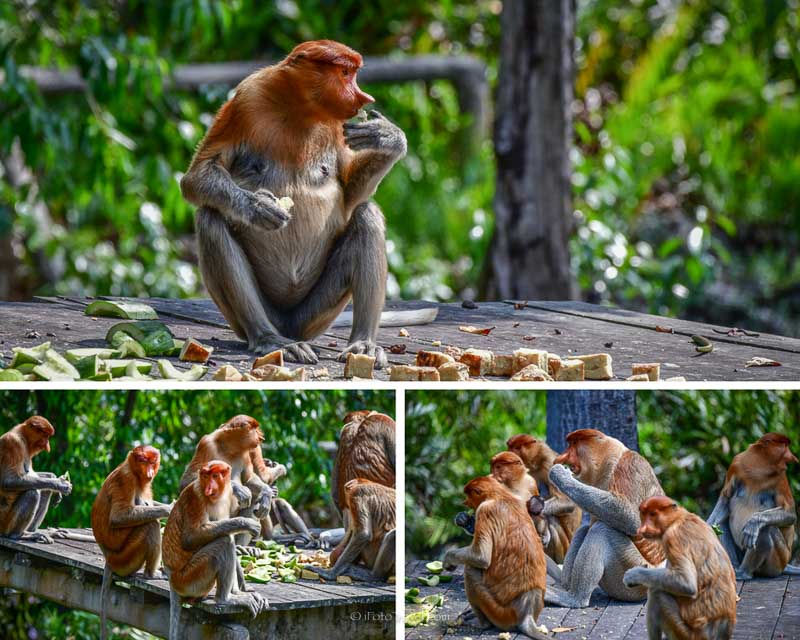
The idea for a monkey sanctuary accidentally came about in 1994.
A local landowner originally bought 400 acres of mangrove forest for commercial reasons.
Whilst palm oil and logging were high on his radar, the owner soon discovered the many groups of proboscis monkeys living on his land.
So he decided to help preserve them.
Hence the Labuk Bay Proboscis Monkey Sanctuary was born.
Feeding Time At Labuk Bay Proboscis Monkey Sanctuary
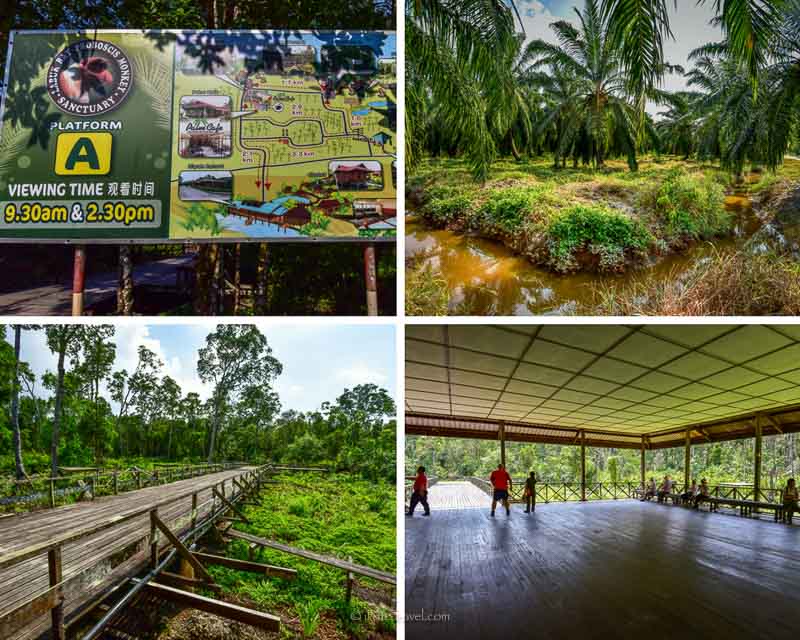
Platform A at the Labuk Bay Proboscis Monkey Sanctuary, surrounded by oil palm plantationsThe monkey sanctuary is 48km from Sandakan and is surrounded by oil palm plantations.
The food sources for the proboscis monkeys has thus become quite depleted.
So the regular feeds at the sanctuary supplement their restricted diet.
These proboscis monkeys are quite wild although habituated.
It is their own choice to come to the feeding platforms. And this arrangement offers amazing opportunities.
Not only can visitors get up close and personal with them but photography is also a breeze too.
No need for long telephoto lenses here!
When you get to the Labuk Bay Proboscis Monkey Sanctuary, there are two major feeding platforms, Platform A and Platform B.
There are four daily feeding times: Platform A is at 9.30 am and 2.30 pm, Platform B at 11.30 am and 4.30 pm.
Labuk Bay Proboscis Monkey Sanctuary – Platform A
We visited the Labuk Bay Proboscis Monkey Sanctuary in mid-April.
By the time our tour group arrived at the Sanctuary, it was early afternoon and in hot and humid conditions, we made our way along an elevated boardwalk.
Through the mangrove jungle towards Platform A, we passed by some macaques on the way.
The multiple small feeding areas around the large undercover platform were deafeningly quiet.
A rainforest hornbill flew overhead.
We could hear an occasional strange call in the distance. Everyone was poised with cameras aimed at the seemingly empty treetops.
Then a few keepers arrived and started to put fruit and vegetables down on the platforms. Within a few minutes as if on cue, wild proboscis monkeys began to appear.
Let The Action Begin
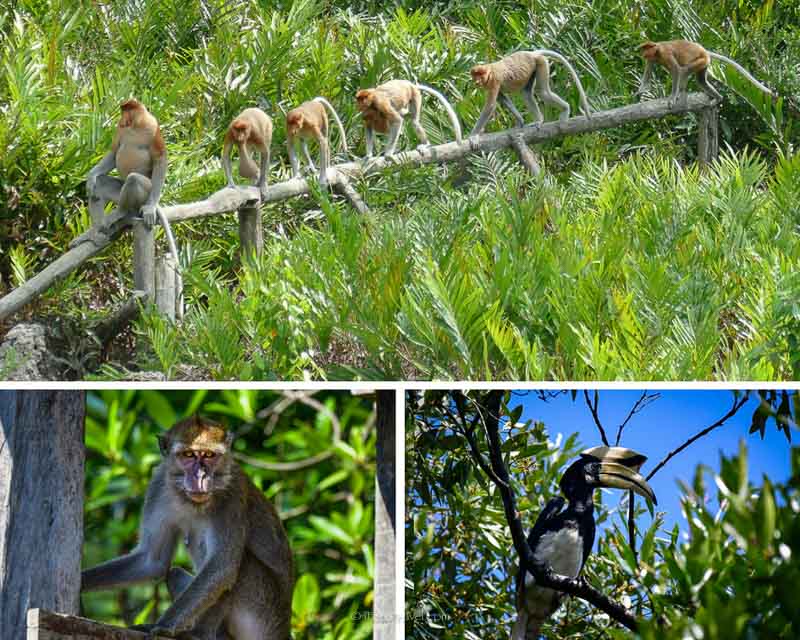
The silence suddenly became a low chatter as one or two appeared. Then more followed and soon there was a commotion.
10, 20 and then up to 40 monkeys just appeared out of nowhere.
Troops rapidly descended from the treetops as we held our breath in awe and excitement.
How could we not have spotted them all before?
There were big fat-bellied, red-faced adult males with huge dangling noses and smaller females monkeys also had rather odd-shaped large noses.
And then there were the babies. Some very young (less than two to three months old) blue-faced ones. The slightly older ones being more grey-faced.
The younger ones held on as mum competed with group members for the best banana or piece of sweet potato.
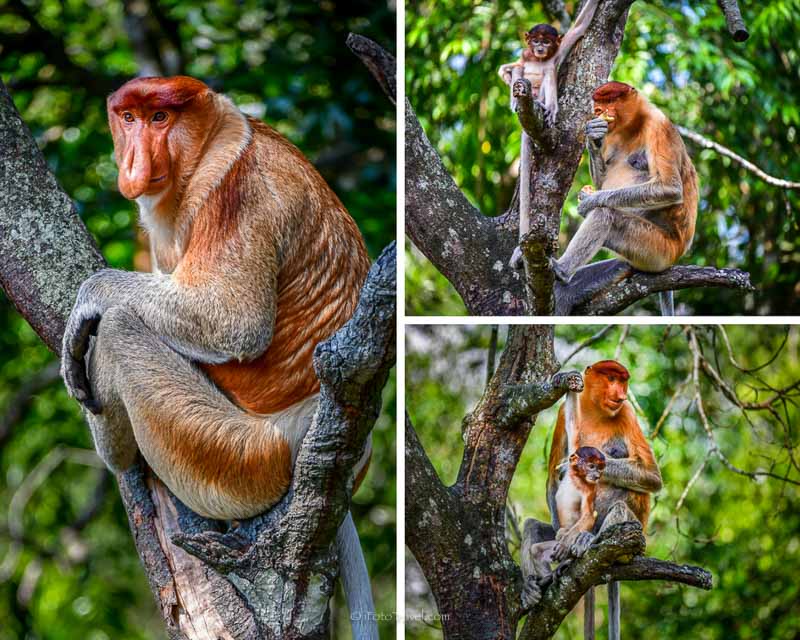
The activity lasted as long as the food did. The monkeys supplement their basic forest diet with these delicacies. But after less than half an hour, the food was gone.
And slowly but surely the troop moved on. Leaping off the platforms and down onto the muddy mangrove floor, back to the forest they disappeared.
And then the silence returned.
Amazing.
A totally surreal experience.
They disappeared back into the forest undergrowth as if nothing had happened.
Labuk Bay Proboscis Monkey Sanctuary – Platform B
Whilst Platform A offers some shade, there is no food or water available but Platform B is in the vicinity of the sanctuary’s restaurant, Nipah (or Palm) Cafe, where there is also a large air-conditioned TV room to watch an informative video about the sanctuary.
Look out for the troop of resident silver leaf monkeys at Platform B as well.
They are known to often sit on the handrails as may the proboscis monkeys.
It is hard to believe that these monkeys are totally wild.
So when they visit the platforms from their natural habitat, what a privilege it is to see them.
A real Borneo Adventure!
Proboscis Monkey Endangered
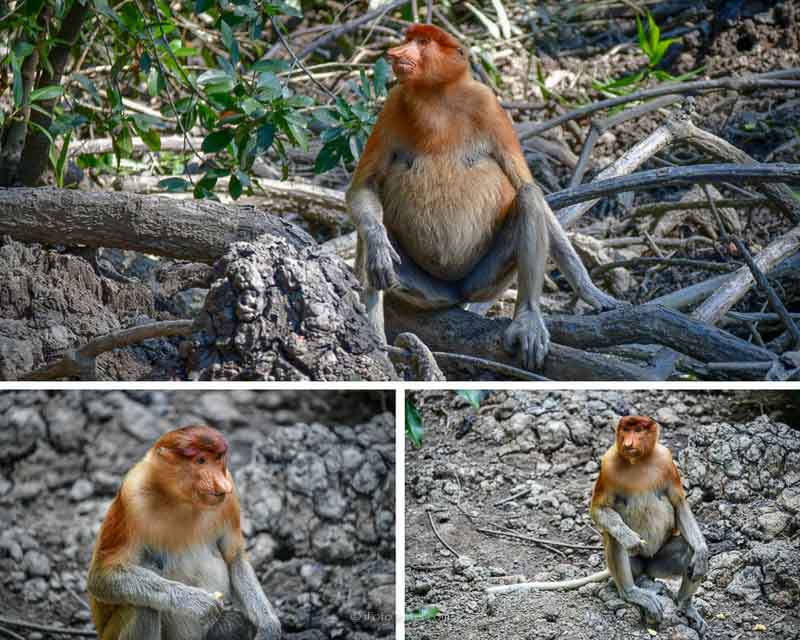
The proboscis monkey is endemic only to the island of Borneo.
Most live in Kalimantan (Indonesian Borneo) with a few elsewhere on the island, including Sabah.
Due to deforestation and hunting for food and Chinese medicines, they are now classified as endangered. In fact, their numbers have halved in only the last 40 years.
At this alarming rate, they will be gone soon, which will be a tragedy indeed, if something isn’t done soon to prevent their extinction.
Habitat Of The Proboscis Monkey
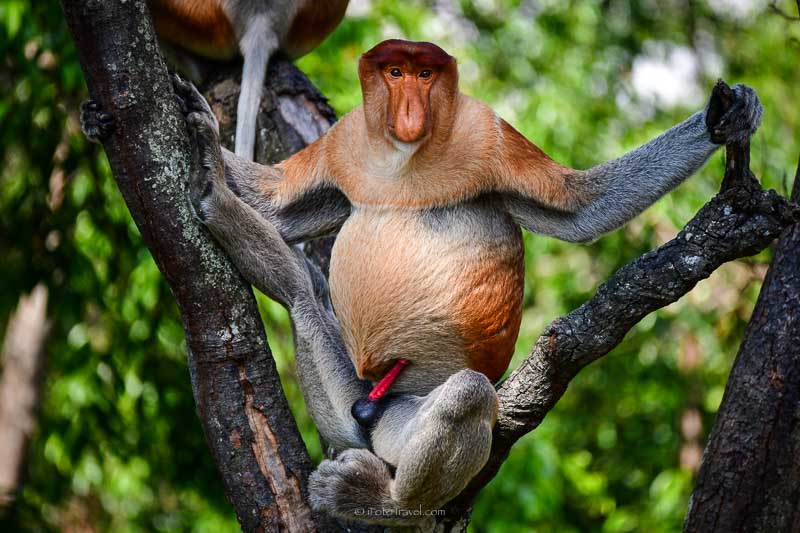
Proboscis monkeys are arboreal, generally living in the trees.
They prefer coastal swamps, mangrove forests and lowland forests with large rivers so they tend to be found within 1km of rivers.
Their diet is mainly fruit and leaves, which is rather seasonal, eaten from January to May and mangrove forest leaves from June onwards.
Proboscis Monkey Facts
1- Male proboscis monkeys have pendulous noses to attract mates.
2- Their large noses act as an echo chamber that amplifies their calls.
3- The proboscis monkey is endemic to Borneo.
4- They live around the island’s rivers, coastal mangroves and swamp areas and only head onto land to find food.
5- Proboscis monkeys live in harem groups that consist of a dominant male and at least two (but often up to seven females) and their offspring.
6- Proboscis monkeys are the champion swimmers among primates.
7- Their web webbed feet and hands allow them to outpace crocodiles.
8- Proboscis monkeys eat leaves, seeds and unripe fruit.
9- Their main predators on land are jaguars and some native people, who view them as a delicacy.
10- Due to deforestation of the rainforests, the proboscis monkey is listed as ‘Endangered’ on the International Union for Conservation of Nature (IUCN) Red List and in Appendix I of the Convention on International Trade in Endangered Species of Wild Fauna and Flora (CITES).
11- Potbellies rule
The mangrove leaves are toxic and so the proboscis monkeys are particularly adapted to this unusual diet.
They have compartmentalized stomachs which contain fermentative bacteria that breaks down the leaves and their toxins.
It is this unusual stomach anatomy that gives the proboscis monkey its huge characteristic potbelly.
In fact, their stomachs can weigh ¼ of their whole body weight.
12- Big-nosed monkeys honk the loudest
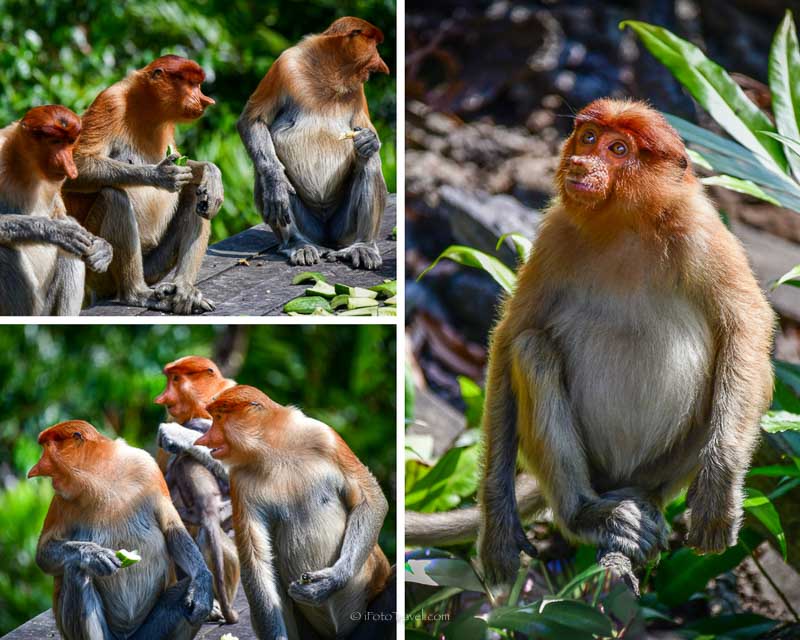
Their odd and unusual noses are the biggest noses of all monkeys. Their large noses are different in both male and females.
It is the rather distinctive bulbous male nose which is thought to be a sexual attractant.
The bigger the nose, the more voluminous the honking call is attractive to a female perhaps.
Perhaps even more so than the bright red penis and black scrotum of the males too!
13- Deep diving monkeys
Did you also know proboscis monkeys are also excellent swimmers?
In fact, they are one of the top swimming primates.
This is probably why crocodiles are one of their main predators.
It has even been suggested their large noses also act like snorkels, although this sounds rather fanciful!
However, they can dive up to an amazing 20 meters and their webbed back feet also well adapt them to their riverside habitat.
14- Proboscis monkeys are not territorial.
So many groups can geographically overlap with others and they live in troops or herds of up to 60 animals.
Males have troops of their own or there are mixed groups and both sexes can move from group to group without fear of aggressive fighting.
This alone is helpful when their forest habitat is rapidly diminishing in size.
How To Get To Labuk Bay Proboscis Monkey Sanctuary
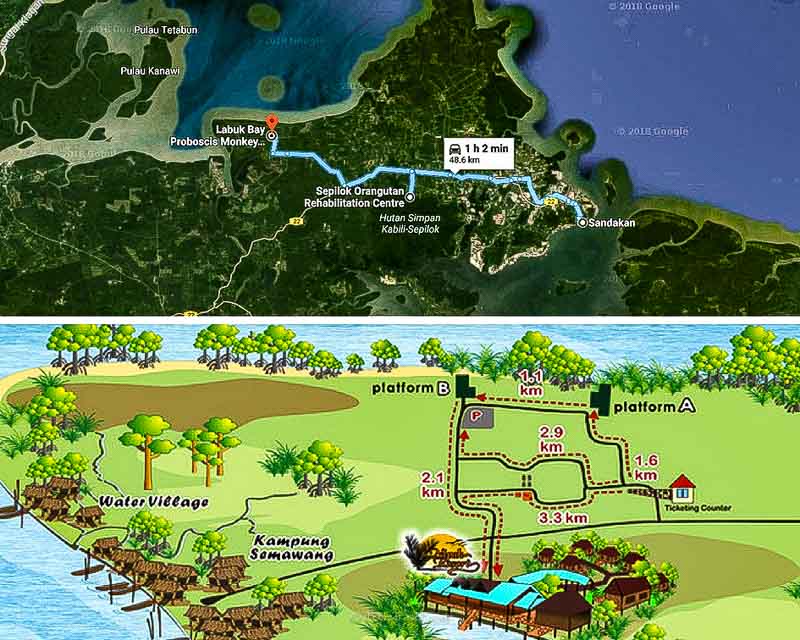
Malaysian Airlines and Air Asia have daily flight times that allow for a day trip to Labuk Bay from Kota Kinabalu.
But if you are staying in Sandakan, then the Labuk Bay Proboscis Monkey Sanctuary has its own transport for visitors.
You can catch the shuttle bus from the Hotel Sandakan. It leaves each day at 0930am, arriving at Sepilok at 1030am, then at Labuk Bay in time for the 1130am feed.
The bus then leaves at 1500pm to return to Sandakan by 1700pm. It costs RM20 (AUD $7) one way.
Entrance Fee To The Labuk Bay Proboscis Monkey Sanctuary
It really is an inexpensive unique and memorable wildlife experience. And the entrance fee for a foreign tourist is only RM60 (AUD $20). A bargain indeed!
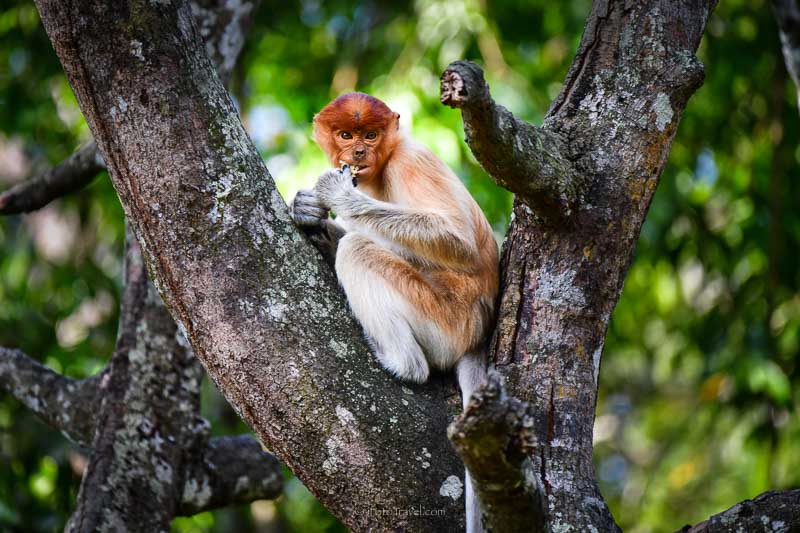
If you are keen on photography, there is an additional camera fee of RM10 (AUD $3) – smart camera phones are exempt though.
Other Sandakan Attractions
Expect to spend at least four hours at Labuk Bay. If you wish to stay longer, there is accommodation at the Nipah Lodge in the Sanctuary. Or stay in Sepilok which is only an hour away and home to the world-famous Sepilok Orangutan Rehabilitation Centre.
Compare prices of hotels in Sandakan here.
The Bornean Sun Bear Conservation Centre is also next door to the orangutan sanctuary, in fact, they share the same car park.
Or if you prefer tropical rainforest flora and birdlife, then you simply must visit the Rainforest Discovery Centre (RDC Sandakan) which has large Exhibition Halls, Plant Discovery Garden, and long canopy walkway offering a great way to discover the Borneo tropical rainforest.
If bats are your thing, check out the Gomantong Caves in Sandakan Borneo too.
While exploring Malaysia, here are some other ideas to check out:
- 20 Famous Landmarks in Malaysia
- 30 Things To Do In Kuala Lumpur
- 35 Things To Do In Penang
- Living in Penang As An Expat
- 20 Things To Do In Melaka
- 15 Things To Do In Sabah
- 15 Things To Do In Cameron Highlands
- Malaysia Airlines Business Class Review
- 21 Beaches In Malaysia
- 20 Things to Do In Kuala Lumpur At Night
- 20 Malaysian Cities
- 16 Overwater Bungalow Resorts In Malaysia
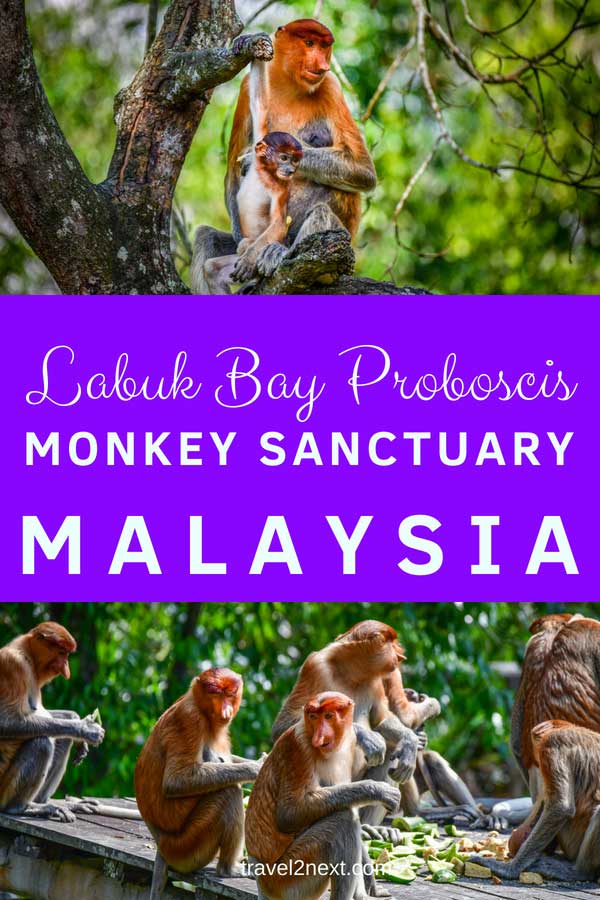
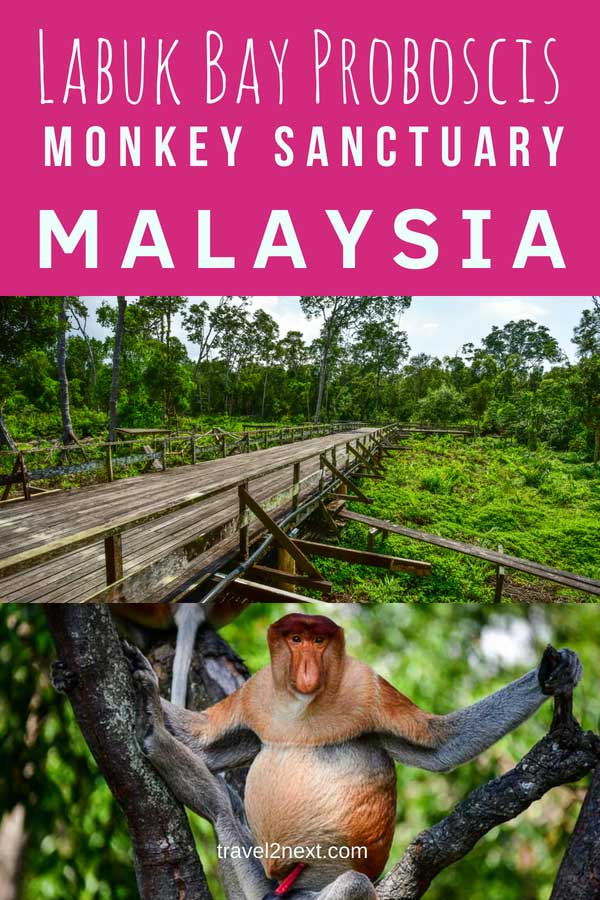
Plan Your Trip

Rent A Car – Find the best car rental rates at Discover Cars. They compare car hire companies to provide you with the best deal right now.

Find A Hotel – If you’re curious about this article and are looking for somewhere to stay, take a look at these amazing hotels.

